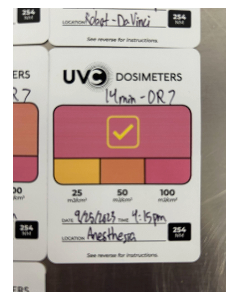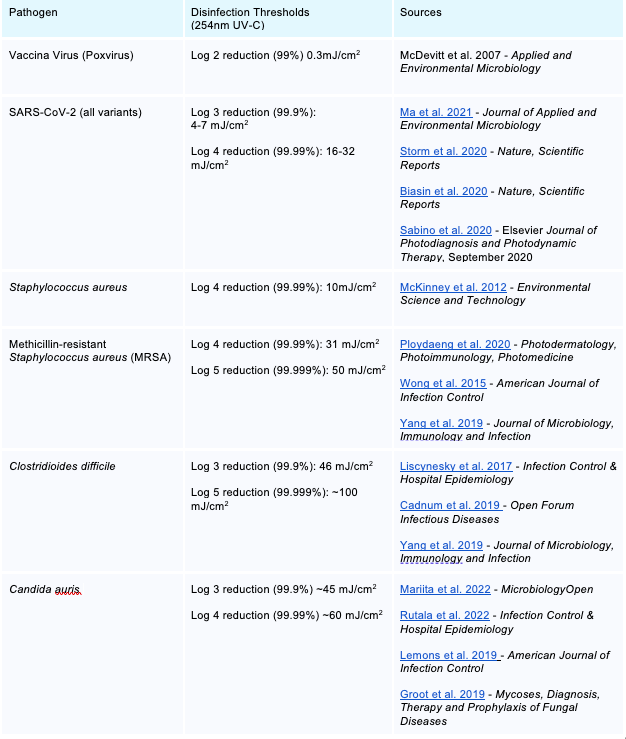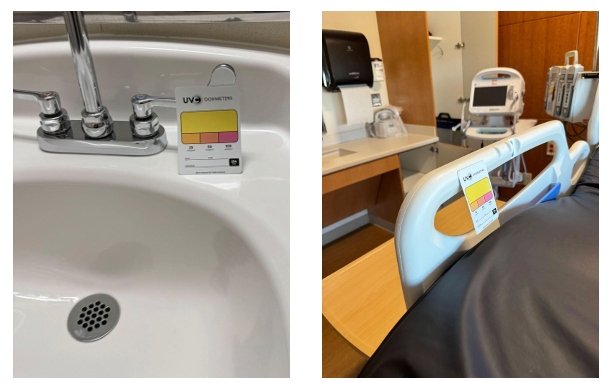How to Be Confident in Your Disinfection: UV-C Disinfection, Dosimeter Cards, and Audits
Recent research in the American Journal of Infection Control reveals gaps in routine hospital disinfection, highlighting the need for UV-C audits. Learn how to validate UV-C dosages effectively and conduct successful audits.
Dosimeter Card
(Source: OhmniLabs)

Research published in the American Journal of Infection Control underscores the insufficiency of routine disinfection procedures in preventing bacterial contamination on critical hospital surfaces, such as manikins, bed rails, and workstations-on-wheels. The presence of lesser-known pathogens within skin flora or environmental bacteria further heightens the risk of infectious diseases, including meningitis and endocarditis.
An audit process can be implemented at any time to assess the efficacy of autonomous UV-C disinfection in achieving comprehensive microbial reduction within hospital environments. This article provides the requisite UV-C dosages and procedural steps essential for conducting a successful audit.
UV-C Dosage and Efficacy
UV-C dosage, denoted in mJ/cm2, signifies the quantity of UV-C light administered to a specific area over a designated duration. It is a pivotal determinant of a UV-C emitting device's effectiveness.
Industry-recognized standards outline the requisite mJ/cm2 thresholds for deactivating various pathogens (Table 1).
Validating UV-C Dosages with Dosimeter Cards
Dosimeter cards serve to validate UV-C dosage, featuring a treated surface responsive to UV exposure, manifesting color changes proportional to received irradiance. Placement of dosimeter cards on high-touch surfaces within the disinfection space before commencing a UV-C disinfection cycle facilitates subsequent assessment of UV-C dosage efficacy. (Table 2)
Table 1: 254nm UV-C dosage for disabling specific pathogens. (Hyperlinks are noted below article)
Source: OhmniLabs

Place the cards in locations of interest in the disinfection space with the yellow surface exposed before a UV-C disinfection cycle starts. Once the disinfection cycle is over, return to the room and review the cards for changes. It is best practice to place the cards on high-touch surfaces and mark them with testing notes. (Table 2)
Executing a UV-C Disinfection
1. Identify the top 10 high-touch surfaces in the room. In a typical hospital room, such as an operating room or patient room, these are typically bed rails, remotes, touch screens, phones, monitoring equipment, faucets, drawers, and closet handles.
2. If using an autonomous solution, map the room, navigating as closely to your chosen target surfaces as possible.
3. Disinfect the room using the appropriate disinfection intensity on your autonomous UV-C device.
Table 2. As the yellow area receives more UV-C exposure, its color changes across the reference spectrum, indicating the amount of irradiance it has received.
Source: Intellego

Conducting a Disinfection Audit
1. Determine the 10 surfaces that you’d like to measure UV-C dosages.
2. Take 10 dosimeter cards. On each card, write the time and date of the audit and the location where it will be placed (e.g., left bed rails, right closet handle, etc.).
3. Remove the adhesive tape on the back and stick each card on its corresponding surface with the yellow exposure surface facing outward.
4. Proceed with your solution’s standard operating steps.
5. After the disinfection is complete, collect all 10 dosimeter cards.
6. Take pictures of the dosimeter cards for record-keeping purposes, as the exposure surface will fade back to yellow over time. Reusing dosimeter cards is not recommended
7. Record the audit details and the dosimeter readings in a spreadsheet. (Table 3)
Table 3. Some advanced UV-C devices provide a guide such as this one to easily modify settings.
(Source: OhmniLabs)

Interpreting Your Results
Compare the readings with the established thresholds in Table 1. If the results are within range to disable the target pathogens in the audit space, consider setting the audit parameters as the operating parameters for your autonomous system.
If the readings do not meet your team’s desired thresholds, reevaluate your solution’s parameters based on these common scenarios:
Dosimeter cards do not show enough color change.
- Reason: Not enough UV-C dosage was delivered across the room
- Remedy: Perform disinfection at a higher intensity with new dosimeter cards
Specific area(s) did not show enough color change.
- Reason 1: Not enough UV-C dosage was delivered to specific target surfaces.
- Remedy 1: Remap the space to navigate closer to target surfaces.
- Remedy 2: Remap the space and add a program with a higher dose of UV-C at the desired area(s).
- Reason 2: Dosimeter cards were not placed within a direct line-of-sight of your solution during disinfection.
- Remedy: Reposition using a new dosimeter card and re-perform disinfection.
Locations.
(Source: OhmniLabs)

Summary
Effective disinfection procedures in health care settings are critical, considering potential bacterial contamination on high-touch surfaces. As such, comprehensive solutions such as autonomous UV-C disinfection utilizing dosimeter cards for validation and executing successful disinfection audits can help combat pathogens within hospital environments.
Resources to Table 1
McDevitt et al. 2007 - Applied and Environmental Microbiology
Ma et al. 2021 - Journal of Applied and Environmental Microbiology
Storm et al. 2020 - Nature, Scientific Reports
Biasin et al. 2020 - Nature, Scientific Reports
Sabino et al. 2020 - Elsevier Journal of Photodiagnosis and Photodynamic Therapy, September 2020
McKinney et al. 2012 - Environmental Science and Technology
Ploydaeng et al. 2020 - Photodermatology, Photoimmunology, Photomedicine
Wong et al. 2015 - American Journal of Infection Control
Yang et al. 2019 - Journal of Microbiology, Immunology and Infection
Liscynesky et al. 2017 - Infection Control & Hospital Epidemiology
Cadnum et al. 2019 - Open Forum Infectious Diseases
Yang et al. 2019 - Journal of Microbiology, Immunology and Infection
Mariita et al. 2022 - MicrobiologyOpen
Rutala et al. 2022 - Infection Control & Hospital Epidemiology
Lemons et al. 2019- American Journal of Infection Control
Groot et al. 2019 -Mycoses, Diagnosis, Therapy and Prophylaxis of Fungal Diseases
Optimizing Drying for Medical Devices: Insights and Strategies From Cheri Ackert-Burr, DNP
April 29th 2024Cheri Ackert-Burr, DNP, BAEd, RN, CNOR, CNS, AGTS, discusses optimizing drying strategies for medical devices, crucial in instrument processing, emphasizing efficiency gains and insights shared at the HSPA Annual Conference.